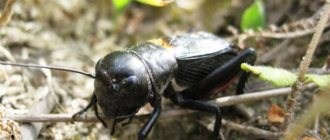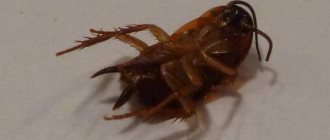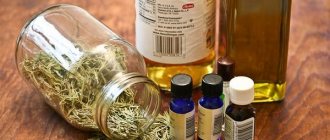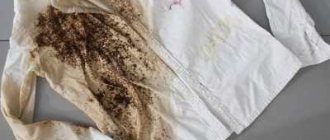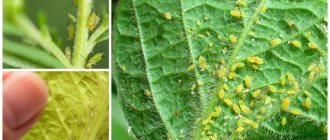Whitefly is a sucking pest of cultivated plants. The insect is small in size and resembles aphids, with the only difference being the white color of the body. It prefers to settle in large groups on young shoots and leaf blades, where it can easily feed on plant sap. The inside of the leaves provides an excellent place for laying eggs. Subsequently, larvae emerge from them, capable of moving independently in search of tender areas of the plant necessary for feeding.
At this stage, whitefly poses the greatest danger to greenhouse crops. After some time, the larvae stop feeding and become inaccessible to all types of insecticides. Their body is covered with a waxy coating. During this period, under reliable protection, the formation of an adult insect occurs. After emerging from a kind of cocoon, the pest firmly attaches itself to the plants and begins to actively drink the juice. At the same time, his body is still reliable, protected by a waxy coating.
Subsequently, the older generation of whiteflies migrates to neighboring plants and the life cycle of the pest repeats again. It is worth noting that insects consume more juice than they need. All excess nutritional fluid is excreted from the body by “honeydew,” which is a fertile environment for the development of many fungal diseases.
Whitefly: what kind of insect is it?
The whitefly, or aleurodidae, is an almost invisible parasite that destroys garden plants. The insect loves indoor flowers, tomato seedlings, peppers, cucumbers, and eggplants. The parasite is especially common in greenhouse conditions. Succulent foliage is eaten by individuals at all stages of life development. To get rid of a butterfly, you need to apply a whole range of preventive measures and use special means for treating summer cottages.
Types and classification of pests
There are about 1,500 species of whiteflies in the world, which differ in habitat and food preferences. In greenhouse conditions, the parasite can constantly multiply, move, and transmit viral and fungal diseases. Eating the lower part of the stems and foliage leads to wilting of plants. Gradual damage to vegetable beds can significantly reduce yields.
Description of the main varieties of whiteflies found in temperate climates:
- Tobacco and cotton. The insect settles on various crops: turnips, beets, cabbage, indoor flowers, outdoor plants, tomatoes, potatoes.
- Greenhouse. It lives in the soil of greenhouses and greenhouses, where the climate is always temperate. Found on indoor plants in warm apartments. This whitefly feeds on vegetable or ornamental crops.
- Citrus. It feeds on tangerine, lemon, orange or lime leaves. In Russia it is found in greenhouses or in the south of Crimea and the Caucasus.
- Cabbage. It settles on cabbage, namely, eats the leaves of the crop at the end of August.
- Strawberry. The whitefly eats strawberry foliage, reduces yield, and harms the fruits of the plant.
Cabbage and strawberry whiteflies are not particularly dangerous for the garden. The insect produces only one offspring during the entire season, and you can get rid of the butterfly invasion by simply washing off the parasite with water. In apartments, aleurodids feed on fuchsia, begonia, orchid, geranium, balsam, passionflower or lantana. They can migrate to neighboring plants.
Habitat and suitable conditions for existence
Whiteflies love warmth and high humidity. Therefore, the parasite can develop year-round in greenhouses, with 3-4 generations present in one area at once. In a garden or greenhouse, the parasite begins to appear en masse in July, when there is intense heat (over 30°C). When the temperature drops below 10°C, adults and larvae die, but eggs laid in the soil are able to overwinter.
This is interesting! You can meet whiteflies in home mini-greenhouses, which are organized on window sills. The insect infects seedlings and then moves to indoor flowers.
Appearance
The whitefly looks like a small moth or white butterfly. The length of the body reaches 2-3 mm. The wings of the pest are covered with a waxy coating, which protects it from the action of chemicals. The parasite larvae are located on the inside of the leaf, on the lower stems of the crop. First instar worms have an oval shape, antennae, and 6 legs. A couple of days after birth, the parasite settles in one place and looks like a microscopic whitish scale. When you shake the affected plant, you may notice a small cloud of small adults.
Life cycle of a whitefly
A female can mate up to 10 times in a month of life. The life cycle of a parasitic butterfly includes many stages, which complicates the fight against insects. The easiest time to get rid of the pest is when the “vagrant” larvae just appear and become vulnerable in search of juicy leaves.
Stages of whitefly maturation:
- the adult female lays eggs;
- after 14 days, first-instar whitefly larvae emerge from the clutch and can search for a suitable habitat for a long time;
- second instar larvae stop at the most succulent areas and become covered with a waxy coating;
- larvae of 3-4 instars, or nymphs, fully feed, but do not yet have the ability to move.
The cycle ends after the adult (imago) begins to move to neighboring plants and beds. Mating of a female with a male occurs 12-20 hours after departure. It is best to kill the insect at this stage, before it has time to lay eggs. The second instar larvae cannot be processed mechanically and are resistant to chemical sprays.
Reproduction and distribution
One individual in just a month of life is capable of laying up to 250 eggs, or 15-20 at a time. After 40 days, adult butterflies develop from the hatched whitefly larvae, which can migrate to other crops and move throughout the greenhouse or garden plot with the help of the wind. The maximum abundance of the pest occurs in July-August, when hot and rainy weather prevails. With the onset of cold weather, the insect dies, but the eggs remain overwintering in the soil to begin their life cycle again in June.
Biological features of the harmful butterfly
Initially, the whitefly lived only in countries with mild and warm climates. But gradually she adapted to life in cold areas. However, warmth and high humidity are the best conditions for it. Biologists have counted about two hundred varieties of harmful flies. They are omnivores and attack any crop. They especially “love” to live in greenhouses and apartments, but if this is not possible, they feel great even on the weeds in the garden.
The size of the butterfly with a white body and transparent wings is small. Males reach a length of 2.5 mm, females - 1.3 mm. The body of the moth is covered with whitish waxy pollen, for which, in fact, it got its name. The pest is a sucking parasite that takes juices from plants. In addition, the butterfly spreads many phytopathogenic viruses. It lives on the inside of leaves, so it is difficult to notice.
Each female lays about 300 eggs per month. They hatch very quickly into gray larvae. They are independent, can move around and look for a place where they can feed. Having found such an area, the larva attaches to the plant and creates a wax cocoon around itself. In this state, it is invulnerable to chemicals. After two weeks, the larva turns into an adult and continues to explore new territories.
Instagram formularosta61
Instagram formularosta61
- House plants
Pests of indoor plants: names, photos and how to deal with them
Signs of insects
You can notice the infection of plants at the initial stage by carefully examining the lower leaves and stems. If small white butterflies appear when shaking the bushes, the whitefly larvae have already caused serious damage to the plant. It is urgent to begin fighting the insect using chemicals, remove infected leaves and bushes from the garden bed, and poison the soil.
The main symptoms that indicate plant damage by the whitefly butterfly:
- the appearance of translucent scales on the reverse side of the leaf;
- whitish sticky coating (honeydew) on the leaves;
- slower plant growth, lack of fertility;
- the appearance of dark spots.
Whitefly traces, or honeydew, are produced by larvae. These secretions can tighten the leaves of the plant, not giving it enough light and moisture. As a result, flower and vegetable crops begin to wither, the leaves curl, turn yellow, dry out, and fall off. The sweetish coating also attracts ants, which can settle in the greenhouse and bring aphids to the plant.
Reasons for the appearance and reproduction of whiteflies
Ideal conditions for the pest are warm and humid summers. At air temperatures below 10°C, the life activity of the whitefly stops, but the insect eggs are well preserved and overwinter.
The pest often appears in dense plantings with poor ventilation. It primarily affects weakened plants.
In summer, the whitefly is carried to the site by the wind and enters the house and greenhouses through open windows and doors.
The insect is brought into the house with bouquets, new potted plants and contaminated soil.
At risk are garden plots next to which there are large greenhouse farms.
Main causes of pest infestation
To prevent crop diseases, you should know where whiteflies come from in greenhouses and on indoor plants. There may be parasite eggs in the soil. Therefore, when planting plants, it is necessary to carefully treat the soil, even if it is purchased. The following conditions also provoke the appearance of butterflies:
- frequent watering of the plant;
- high humidity and temperature more than 30°C in the greenhouse, rainy hot summer;
- close planting of crops to each other;
- lack of ventilation in greenhouses, greenhouses, apartments.
A pest can enter an apartment through open windows and doors. Therefore, it is recommended to regularly inspect the leaves of indoor plants and wipe them with disinfectants. Also, do not place flowers too close to each other.
Prevention
- Constant inspection of the leaves will help to detect the insect in time. New plants in the house should be quarantined.
- Because whitefly is most common indoors, it is important to thoroughly clean and disinfect greenhouses and conservatories after harvest. Plant residues and weeds are collected and disposed of or composted. The soil is turned over and leveled only in the spring.
- In summer, screens are placed on doors and shutters to prevent insects from entering.
- Greenhouses are cleaned and disinfected, paying attention to cracks and joints. After the onset of cold weather, it is best to leave the windows and doors open so that the pests that have settled there for the winter die. At temperatures of -12°C and below, it is enough to freeze the greenhouse for a week.
Although the whitefly multiplies quickly, it can and should be combated. Only systematic actions will help get rid of it. Once you start fighting it, don't stop!
Learn more about whitefly control in this video.
What harm is caused?
Honeydew, which the whitefly leaves on the leaves, provokes the appearance of sooty fungus. It clogs the pores of the plant, which is why the crop gradually dies from lack of oxygen and sun. The spores spread in the wind and remain in the soil. Therefore, a small butterfly can cause crop destruction in the entire greenhouse. Infected plants are removed from the site and burned.
Whitefly is a carrier of the following diseases: leaf curl virus, golden mosaic, infectious yellowing of fruits and crop stems. When the first symptoms appear, treatment is useless; it is necessary to urgently get rid of the affected plants.
Read more about how to effectively get rid of butterfly pests in your garden and vegetable garden in the article here.
What plants does the pest attack?
This insect attacks more than 300 plant species. Among vegetables, tomatoes suffer most from whitefly. From them he can switch to cucumbers, squash, pumpkins, and eggplants. Cabbage, strawberries, beans, lettuce.
Fruits and berries such as pear, plum, apple, raspberry, currant, gooseberry and honeysuckle are not ignored.
Indoor flowers such as begonias, geraniums, fuchsias, impatiens, myrtles, poinsettias, gerberas, cacti, orchids, cyclamens, viburnums, primroses should be protected from pests all year round. Damages garden flowers: asters, gladioli, tobacco, zinnias.
Different types of whiteflies cannot reproduce on the same plant because their secretions repel each other.
Means to combat butterflies and their larvae
It is not easy to eliminate the pest from the beds, but if you use an integrated approach, it will be possible to defeat several generations of whiteflies at once. Chemical treatment of soil and plants against parasites should take place before planting seedlings and before the start of the vegetative stage. Folk recipes, mechanical methods and biological products are allowed to be used throughout the spring-summer season. In enclosed spaces, special fumigators deal with the butterfly.
10 ways to get rid of whitefly butterflies forever
Glue traps
To combat adult individuals, sticky traps are used. When flying from plants or beds, most whiteflies fall into placed traps. You can buy them in gardening stores, use regular sticky fly strips. You can make a trap yourself from cardboard or plastic, smeared with rosin, honey, Vaseline, or entomological glue. The parasite is also attracted to light from a light bulb, which burns their thin wings.
This is interesting! Homemade traps should be made on sheets, plywood, yellow or blue plastic. It is these shades that are attractive to insects.
Chemicals
Chemicals help get rid of whiteflies quickly and protect plants for another 4-8 weeks. Insecticides enter the insect's body and intestines (intestinal-contact effects), causing complete paralysis and death from exhaustion within 2-3 days. It is not recommended to treat vegetable crops with toxins after flowering and the appearance of ovaries. Chemicals can also poison the population of beneficial insects: ladybugs, bees, wasps, lacewings.
“Fitoverm”
The safest insecticide that will remove whiteflies will not harm the health of humans, animals, or other beneficial insects. It is recommended to spray the soil, foliage, and inflorescences of plants. To exterminate all pests, 2 treatments with a break of 7 days are enough. The composition is effective for 3 weeks, becoming less effective after rains. An analogue of the product is “Match”, “Aplaud”.
“Aktara”
A universal chemical preparation allows you to immediately poison whiteflies, aphids, midges, and leaf beetles. The toxin from the soil is absorbed into the foliage and stems of plants and remains active for about 5 weeks. If you need to kill large concentrations of pests, you can make a concentrated solution. To do this, a bag of Aktara is diluted in 3 liters of water, instead of 10 liters. This dose will kill all butterflies and larvae, but the seedlings will not be harmed.
"Spark"
“Golden Spark”, “Iskra – double effect”, “Bio-Iskra” are sold in the form of sticks, tablets, ampoules, which are used according to the instructions. The chemical preparation will save the crop from whiteflies and aphids after just one spraying. An irrigated bush contains toxins for up to 30 days, during which time the entire pest population dies.
You should not re-treat plants with the same preparation. The insect will be able to adapt to the toxic composition.
Folk recipes
The fight against whiteflies at home begins with the use of folk methods. Recipes based on herbal decoctions, infusions, household chemicals, and improvised means allow you to get rid of many pests. The natural composition of solutions for spraying beds does not accumulate in the soil, promotes better productivity, does not harm beneficial insects, and does not burn seedlings.
Soapy water
The soap solution washes off the protective wax film from the insect, paralyzes it, and causes death within 2-3 days. To prepare the product, you need to take a bar of laundry or tar soap, grate it and dilute it in 6-7 liters of water. You can spray the bushes with a spray bottle or manually wash each leaf with a foam sponge.
Garlic infusion
The tincture is used to treat indoor plants. To prepare it, just pour 2 chopped cloves of garlic with boiling water and place in a dark and cool place for a day. After infusion, the product is filtered and poured into a spray bottle. To kill the entire whitefly population, treatment is carried out every week for a month.
Infusion of yarrow herb
You can get rid of whiteflies using yarrow juice. To prepare the infusion, take several bushes, chop it finely, knead it with your hands, and pour 4 liters of boiling water. The product is infused for 2 days, then filtered and diluted with another 4 liters of water. For better adhesion of the composition, it is recommended to add about 30-40 ml of liquid soap or shampoo before processing the beds. The medicinal plant can be replaced with celandine.
Tobacco infusion
Tobacco can be used to control small infestations of whiteflies. You need to buy 1 pack of cheap cigarettes, take out the contents, pour 1 liter of boiling water. To infuse, the mixture is sent to a dark and cool place for 5 days. After the strained product, spray the affected plants every 3 days.
Dandelion decoction
To prepare the product, take juicy dandelion bushes (along with roots), chop them finely, pour in 1 liter of boiling water, and then leave the mixture on low heat for 15 minutes. To make the tincture, the herbal decoction is sent to a dark place for 4 days. If it is necessary to treat greenhouses, greenhouses or garden beds, the serving volumes increase 10 times.
Ammonia
The pungent smell of ammonia repels small pests, fertilizes the soil, and helps enhance the growth and flowering of indoor plants. 2 tbsp is enough for a bucket of water. l. ammonia, 30 ml of liquid soap. Treatment is carried out after 18.00 or in cloudy weather, so as not to burn the tender leaves of the seedlings under the scorching sun.
On a note! You can replace ammonia with vinegar. Its smell is also harmful to insects.
Ash
Wood ash helps save beds from whiteflies, fleas, and aphids. It is sprinkled on the soil under the plants, treated between rows or irrigated with a solution on the foliage. You need 1 tbsp. ash, pour 5 liters of water, boil over low heat for about 15 minutes. Afterwards, the broth is cooled and the beds are irrigated with a broom.
Sugar tincture
Sugar infusion is suitable for preventing the appearance of whiteflies on plants. Plants that were in the same greenhouse or nearby with affected crops are treated with a safe product. To prepare the solution, take 200 g of sugar, 1 liter of warm water, mix the ingredients and spray the leaves.
In order for the plant to receive sufficient oxygen and light, 5-6 days after treatment, the sugar solution must be washed off from the leaves.
Mechanical methods
Control whiteflies in small areas manually. It is enough to inspect each leaf of the plant from the inside several times a week. If larvae and butterflies are found, they are shaken off, killed, and washed off with soapy water. Regular watering with a hose is also recommended to force pests down to the ground.
Biological measures
Biological insecticides act in the same way as chemicals, but have a more natural, safe composition. The treatment can be carried out after the formation of the ovaries, does not make the fruits toxic, and the fumes do not harm humans and animals. The most effective product, Verticillin G, contains spores of a fungus that is dangerous to insects. After poisons enter the intestines, the whitefly begins to get sick, infects other individuals and dies after 8-10 days.
Biological measures also include introducing beneficial insects into the beds that feed on whiteflies. Encrasia is a parasitic parasite that lays its eggs in butterflies. It can also suck juice from immobile larvae. Ladybugs and macrolophus bugs love to eat the parasite. To attract predators, dill, marigolds, and daisies are planted around the perimeter of the site.
Fumigators
In greenhouses, conservatories and apartments, you can use a fumigator against mosquitoes and flies. They are placed around the perimeter at an equal distance from each other, windows and doors are closed. While the device is active, you must leave the premises and take your pets. Toxic fumes are effective on butterflies and larvae, but are not harmful to eggs. Therefore, after a few weeks the procedure is repeated.
Brief description of the pest
If a whitefly appears on cucumbers or tomatoes in a greenhouse, then it is not difficult to detect. This is a small white butterfly, barely 2 mm long. It affects not only cucumbers; it can also affect flower crops, fruit and berry plants, tomatoes, and eggplants.
Two types of whiteflies attack most crops:
- tobacco whitefly (Bemisia tabaci);
- greenhouse (Trialeurodes vaporariorum) - mainly affects greenhouse vegetables.
What does a butterfly and its larva look like?
The insect can move on its own legs and fly from one bush to another. The butterfly does not live long - 2-3 weeks, but in such a short period of time the female lays 100-200 eggs. Greenhouse whitefly eggs are first white, then gray.
After a week and a half, the larvae emerge from the eggs, go through 4 phases of life, and mature. The female lays eggs on the back of the leaves. This is where most of the life of butterflies and their larvae takes place.
The larvae are called nymphs. They are light, flat, not very mobile and virtually invisible to the naked eye (0.3 mm long). Their presence can be checked using a magnifying glass. They look like small yellow scales with reddish eyes. Their body is covered with thorns. Having entered the last phase, the larva gains the ability to move on its paws. After 3-4 days, she matures and begins to lay eggs. From half of the eggs females are born, giving 10-12 generations per year.
Adult whiteflies leave the greenhouse in the summer, usually in July, and feed on garden plants, choosing weeds and hollyhocks. Insects return to the greenhouse again in the fall when there is no food available outdoors.
The insect goes through all stages of development from egg to butterfly in 25-26 days. Due to the cyclical development of the insect and its fertility, it is very difficult to fight it. Below we describe in detail how to deal with whiteflies if they are infested in a greenhouse.
Insect damage
The size of the butterfly and its larvae is small, but the insect can cause great harm. Here are the negative consequences that occur with vegetable bushes attacked by the pest:
- Larvae and adult insects suck tissue sap. First, small yellowish spots appear on the leaves (less often on young shoots). If you carefully examine the sheet from the underside, you can see small traces of punctures. Later, a large area of leaves turns yellow, dries out and falls off. As a result, the plant weakens.
- The rate of growth and development of plants slows down, while susceptibility to unfavorable factors increases.
- If the pest parasitizes the inflorescences, the number of ovaries is greatly reduced.
- The whitefly secretes a sticky, sweetish substance that attracts ants. Plants covered with a sticky substance have limited respiration ability and are unsightly. Honey dew secreted by whiteflies is more viscous than that secreted by aphids; it can significantly impede the movement of beneficial insects - the whitefly's natural enemies.
- A sooty fungus settles on the sticky formation, and secondary infection of the bushes occurs. The fungus grows on the leaves, reducing photosynthesis and transpiration. The fungus on the fruit makes it sticky and the fruit is not suitable for sale.
- The greenhouse whitefly can disfigure ornamental plants, cause them to die, and reduce the yield of edible plants.
- With a massive attack of insects, the bush dies.
- These insects are also carriers of viruses.
Symptoms of damage to cucumbers and tomatoes
The appearance of whiteflies in a greenhouse can be determined by characteristic symptoms:
- small white midges hover over the bushes;
- whitish dots appeared on the leaves;
- a sticky mass appeared on the shoots and leaves;
- curling and wilting of leaves;
- the formation of yellow spots on the leaves with unclear edges;
- there are larvae on the back of the leaves;
- bushes develop poorly;
- bushes shed their leaves prematurely.
Terms and rules for processing plants
Treatment should be carried out at least 3 times per season. The soil is irrigated with chemicals for the first time in May-June, then a few weeks after planting the seedlings, the procedure is repeated. The last spraying will be in July. If large concentrations of pests are noticed at the dacha, you need to immediately begin treating the plants using traditional methods. Soap solutions and herbal decoctions can be used every week until the whitefly completely disappears.
Treatment of plants with chemicals should take place in an open area or in a ventilated area. For protection, wear gloves, thick clothing, and a respirator. After spraying poisons, you cannot work in the beds for several days, since an invisible poisonous cloud still remains above them. After the formation of ovaries, chemicals are contraindicated. The harvest is not harvested until several months after the plants are irrigated with toxins.
Treatment of plants against whiteflies should occur in calm, cloudy weather. If it rains after spraying with natural remedies, repeat the procedure again. 30-40 ml of liquid soap is added to any solution, which ensures better attachment of the composition to the leaves.
What to do if whiteflies appear in a greenhouse with eggplants (emergency work)
Juicy eggplant leaves are an excellent feeding ground for pest larvae. Clutches of eggs and larvae are located on the underside of leaf blades, so inexperienced summer residents do not immediately determine the presence of whitefly.
How to understand that this dangerous enemy has “settled” in the greenhouse:
- plant leaves curl and wither;
- noticeable wilting of seedlings;
- eggplant bushes stop growing and turn yellow;
- when you touch parts of the plant (leaves, stems), your palm feels sticky;
- some leaves are covered with shapeless yellow-brown spots;
- On the reverse side of the plates, larvae are visible - microscopic grayish grains.
Fumigator against whitefly
Fumigators (with liquid, plates) against flies or mosquitoes can significantly reduce the population of whiteflies. It is necessary to turn on the fumigator as close as possible to the affected plants, close windows and doors. People and animals are not allowed to stay in the room - there is a high risk of poisoning.
Whiteflies cannot tolerate chemical fumes from fumigators
How to get rid of whiteflies on eggplants indoors: control measures
Only comprehensive measures give the full effect, while the gardener must try to identify the causes and ways of the pest appearing in the greenhouse.
Various methods are used to fight:
- mechanical;
- biological;
- chemicals.
For small numbers of insects, results are achieved by treatment with compositions prepared according to folk recipes. Typically, such solutions are prepared from drugs and herbs that are safe for plants and human health, so they are suitable for processing indoors. “Chemistry” is used in particularly difficult cases when other methods are ineffective.
Mechanical means
Special glue traps for the insidious whitefly are very popular among gardeners. They are sold in stores, and they are also easy to make yourself. The device consists of boards painted in a bright color (yellow or blue) and covered with a sticky layer. Moths, attracted by the bright color of the trap, sit on the boards and tightly stick to them. Hang yellow “traps” throughout the greenhouse, in the center, since pests fly up to them from the sides. Over time, when the surface of the trap is completely covered with numerous pests, the boards are cleaned and hung again.
It’s easy to make such a device with your own hands:
- cut small rectangular sheets from cardboard or thick paper;
- take rosin, castor oil, petroleum jelly in small quantities;
- First, heat rosin (preferably in a water bath), add castor oil, then Vaseline and a little honey;
- the mixture is cooled;
- applied to cardboard on both sides;
- traps are hung over eggplant plantings in a greenhouse.
Plywood is suitable instead of cardboard. The workpiece is first coated with paint (it is better to choose a yellow color that attracts whiteflies), allowed to dry, and a sticky composition is applied. This device can be used for a couple of seasons.
How to recognize a whitefly infestation
Whitefly infestation is not easy to detect at the initial stage. This is explained by the fact that the insect nests mainly on the underside of the leaves, and its larvae are so small that they resemble small scales.
How to recognize greenhouse whitefly
One of the characteristic signs that a plant is affected by whitefly is the appearance of whitish or yellow spots with blurred boundaries. The plants take on an unhealthy, depressed appearance; on the underside of the leaves you can see light tubercles - places where second-instar larvae accumulate.
When examining the leaves, their deformation and curling are noted. After a short time, the affected leaves turn yellow and die.
Clusters of whitefly larvae on the underside of a leaf
The secretions of the larvae cover the plant with a sticky coating, which is easily detected when touched. This plaque clogs the pores of the leaves, preventing natural photosynthesis and normal plant development. If black velvety spots are found on the leaves, then we are talking about a concomitant disease - sooty fungus, which is carried by whiteflies.
If any of the listed signs of an unhealthy plant appear, urgent measures should be taken to save the crop.

